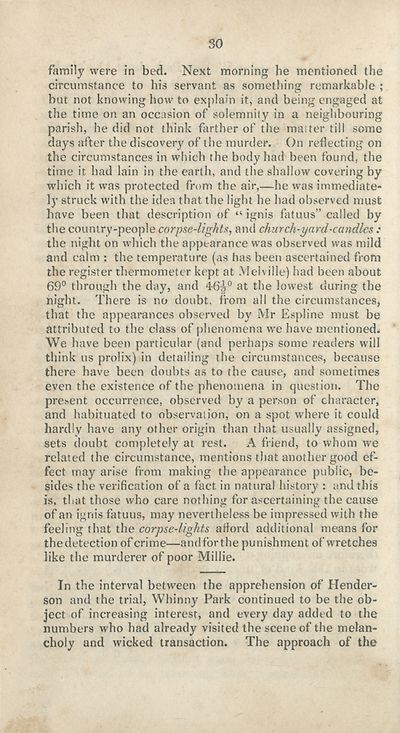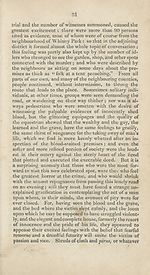Download files
Complete book:
Individual page:
Thumbnail gallery: Grid view | List view

30
family were in bed. Next morning be mentioned the
circumstance to his servant as something remarkable ;
but not knowing how to explain it, and being engaged at
the time on an occasion of solemnity in a neighbouring
parish, he did not think farther of the matter till some
days after the discovery of the murder. On reflecting on
the circumstances in which the body had been found, the
time it had lain in the earth, and the shallow covering by
which it was protected from the air,—he was immediate¬
ly struck with the idea that the light he had observed must
have been that description of “ ignis fatuus” called by
the country-people corpse-lights, and church-yard-candles:
the night on which the appearance was observed was mild
and calm : the temperature (as has been ascertained from
the register thermometer kept at Melville) had been about
69° through the day, and -tAg0 at the lowest during the
night. There is no doubt, from all the circumstances,
that the appearances observed by Mr Espline must be
attributed to the class of phenomena we have mentioned^
We have been particular (and perhaps some readers will
think us prolix) in detailing the circumstances, because
there have been doubts as to the cause, and sometimes
even the existence of the phenomena in question. The
present occurrence, observed by a person of character,
and habituated to observation, on a spot where it could
hardly have any other origin than that usually assigned,
sets doubt completely at rest. A friend, to whom we
related the circumstance, mentions that another good ef¬
fect may arise from making the appearance public, be¬
sides the verification of a fact in natural history : and this
is, that those who care nothing for ascertaining the cause
of an ignis fatuus, may nevertheless be impressed with the
feeling that the corpse-lights afford additional means for
thedetection of crime—andforthe punishment of wretches
like the murderer of poor Millie.
In the interval between the apprehension of Hender¬
son and the trial, Whinny Park continued to be the ob¬
ject of increasing interest, and every day added to the
numbers who had already visited the scene of the melan¬
choly and wicked transaction. The approach of the
family were in bed. Next morning be mentioned the
circumstance to his servant as something remarkable ;
but not knowing how to explain it, and being engaged at
the time on an occasion of solemnity in a neighbouring
parish, he did not think farther of the matter till some
days after the discovery of the murder. On reflecting on
the circumstances in which the body had been found, the
time it had lain in the earth, and the shallow covering by
which it was protected from the air,—he was immediate¬
ly struck with the idea that the light he had observed must
have been that description of “ ignis fatuus” called by
the country-people corpse-lights, and church-yard-candles:
the night on which the appearance was observed was mild
and calm : the temperature (as has been ascertained from
the register thermometer kept at Melville) had been about
69° through the day, and -tAg0 at the lowest during the
night. There is no doubt, from all the circumstances,
that the appearances observed by Mr Espline must be
attributed to the class of phenomena we have mentioned^
We have been particular (and perhaps some readers will
think us prolix) in detailing the circumstances, because
there have been doubts as to the cause, and sometimes
even the existence of the phenomena in question. The
present occurrence, observed by a person of character,
and habituated to observation, on a spot where it could
hardly have any other origin than that usually assigned,
sets doubt completely at rest. A friend, to whom we
related the circumstance, mentions that another good ef¬
fect may arise from making the appearance public, be¬
sides the verification of a fact in natural history : and this
is, that those who care nothing for ascertaining the cause
of an ignis fatuus, may nevertheless be impressed with the
feeling that the corpse-lights afford additional means for
thedetection of crime—andforthe punishment of wretches
like the murderer of poor Millie.
In the interval between the apprehension of Hender¬
son and the trial, Whinny Park continued to be the ob¬
ject of increasing interest, and every day added to the
numbers who had already visited the scene of the melan¬
choly and wicked transaction. The approach of the
Set display mode to:
![]() Universal Viewer |
Universal Viewer | ![]() Mirador |
Large image | Transcription
Mirador |
Large image | Transcription
| Antiquarian books of Scotland > Crime & punishment > Whinny Park murder > (44) |
|---|
| Permanent URL | https://digital.nls.uk/126151193 |
|---|
| Description | Thousands of printed books from the Antiquarian Books of Scotland collection which dates from 1641 to the 1980s. The collection consists of 14,800 books which were published in Scotland or have a Scottish connection, e.g. through the author, printer or owner. Subjects covered include sport, education, diseases, adventure, occupations, Jacobites, politics and religion. Among the 29 languages represented are English, Gaelic, Italian, French, Russian and Swedish. |
|---|

